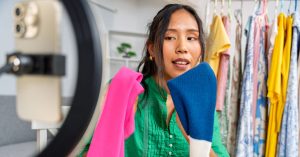In the ever-evolving world of fashion, staying ahead of trends is crucial for brands, influencers, and consumers alike. Over the decades, the platforms that dictate fashion trends have shifted dramatically—from the glossy pages of fashion magazines in the early 2000s to the rise of style blogs and Instagram in the 2010s. Now, a new platform has taken the reins: TikTok.
With over 1 billion active users as of November 2022, TikTok has rapidly become the go-to platform for discovering what’s hot in fashion. Its influence is undeniable, transforming not just how trends are created but also how they are consumed and adapted across the globe. Here’s a deep dive into why TikTok has become the breeding ground for fashion trends and how it’s reshaping the industry.
The Rise of TikTok in Fashion
In recent years, TikTok has emerged as a dominant force in the fashion industry, dramatically shifting how trends are created, shared, and consumed. Once known primarily for its dance challenges and viral memes, TikTok has quickly evolved into a key player in the fashion world, with its influence now rivaling that of more established platforms like Instagram. This shift is largely due to TikTok’s unique combination of massive reach, authenticity, and its ability to quickly turn everyday items into must-have fashion statements.
TikTok’s Massive Influence
TikTok’s rise in the fashion industry can be attributed to its vast and diverse user base. As of November 2022, TikTok boasted over 1 billion active users, providing an unparalleled platform for the rapid dissemination of fashion trends. Unlike Instagram, where fashion content is often polished and curated, TikTok thrives on authenticity and spontaneity. This unfiltered approach resonates with a younger audience, who value genuine expression over carefully staged posts. As a result, TikTok has become the go-to platform for discovering new trends and styles, with many users referencing the app as their primary source of fashion inspiration.
The impact of TikTok on fashion trends is evident in the way certain products have become viral sensations almost overnight. The hashtag #TikTokMadeMeBuyIt has driven countless trends, from Birkenstock clogs to the now-iconic Skims dress. This trend-setting power has not only popularized individual products but has also had a significant impact on the brands behind them. For instance, Aeropostale’s “mom jeans” saw a resurgence in popularity after TikTok users began embracing looser denim styles. This led to a 40% increase in sales of loose denim for the brand, highlighting TikTok’s ability to revitalize products and even entire brands.
Democratization of Fashion Trends
One of the key reasons for TikTok’s rise in the fashion industry is its role in democratizing fashion trends. On TikTok, anyone can become a trendsetter, regardless of their follower count or industry connections. This has led to a more diverse and inclusive fashion landscape, where trends emerge from all corners of the platform. Users on TikTok are not just passive consumers of fashion; they actively participate in the creation and evolution of trends, often adding their unique twists to popular styles.
TikTok’s format encourages creativity and self-expression, allowing users to showcase their personal styles in innovative ways. The platform’s short-form video content is perfect for trend demonstrations, fashion challenges, and styling tutorials, all of which contribute to the viral nature of fashion trends on TikTok. The platform’s algorithm also plays a crucial role in amplifying these trends, pushing content to users who are most likely to engage with it, regardless of whether they follow the original creator.
Impact on Established and Emerging Brands
Brands, both established and emerging, have recognized the immense potential of TikTok and are increasingly leveraging the platform to reach new audiences. Luxury brands like Burberry have embraced TikTok to maintain their relevance among younger consumers, while retailers like Banana Republic have used the platform to reconnect with their customer base. The platform has proven particularly beneficial for smaller, niche brands that might struggle to gain visibility on more saturated platforms like Instagram.
TikTok’s influence has also prompted other social media platforms to adopt similar features. Instagram’s introduction of Reels, YouTube Shorts, and Amazon’s and Etsy’s short-form video feeds are all responses to TikTok’s success. However, despite these efforts, TikTok remains the leader in setting and spreading fashion trends.
From Microtrends to Viral Phenomena
TikTok has transformed the fashion landscape, turning microtrends into global phenomena almost overnight. In the past, fashion trends would take months or even years to develop, often guided by designers, magazines, and influencers on platforms like Instagram. However, TikTok has upended this traditional timeline, making it possible for trends to go viral in a matter of days, if not hours.
The Birth of Microtrends on TikTok
Microtrends are small, niche trends that emerge within specific communities or subcultures on TikTok. These trends often start with a few users showcasing a particular style, item of clothing, or aesthetic that resonates with their audience. For instance, a user might post a video of themselves wearing a unique piece of vintage clothing or a quirky accessory. If the video gains traction, it can inspire others to adopt the trend, creating a ripple effect that spreads across the platform.
One of the key reasons microtrends flourish on TikTok is the platform’s algorithm, which is designed to promote content based on user engagement rather than follower count. This means that a trend started by a relatively unknown user can gain as much visibility as one started by a major influencer. The algorithm amplifies content that resonates with viewers, allowing microtrends to quickly gain momentum and reach a broader audience.
From Niche to Viral: How Microtrends Explode
What sets TikTok apart from other platforms is its ability to turn these microtrends into viral phenomena. The platform’s short-form video format is ideal for showcasing quick, visually appealing content, which is perfect for fashion. As users scroll through their feeds, they are constantly exposed to new ideas and styles, many of which they are inspired to try themselves. This leads to rapid adoption of trends, as users create and share their interpretations, further fueling the trend’s growth.
The hashtag #TikTokMadeMeBuyIt is a prime example of how microtrends can explode into mainstream phenomena. Products that might have once been considered niche or obscure can suddenly become must-haves, thanks to TikTok’s influence. Items like Birkenstock clogs, L.L. Bean tote bags, and the viral strawberry dress are just a few examples of how TikTok has catapulted products into the fashion spotlight.
The Speed and Ephemerality of TikTok Trends
While TikTok’s ability to create viral trends is impressive, it also comes with a downside: the rapid turnover of trends. The same speed that propels microtrends to virality also means that these trends can fade just as quickly. What is popular one week might be passé the next, as users move on to the next big thing. This ephemerality is a defining characteristic of TikTok fashion, where trends are often short-lived but highly intense.
For brands, this presents both opportunities and challenges. On one hand, brands can capitalize on viral trends to boost sales and visibility. On the other hand, they must be agile enough to keep up with the fast-paced nature of TikTok trends. Those that succeed are often the ones that can quickly adapt to new trends and incorporate them into their marketing strategies.
The Broader Impact on Fashion
The rise of TikTok-driven trends has had a significant impact on the broader fashion industry. It has democratized trendsetting, giving everyday users the power to influence fashion in ways that were previously reserved for designers and high-profile influencers. This shift has led to a more diverse and dynamic fashion landscape, where trends emerge from all corners of the globe and reflect a wide range of styles and preferences.
Moreover, TikTok has blurred the lines between high fashion and streetwear, luxury and everyday items. A single video can elevate a simple hoodie or a pair of jeans to cult status, while also bringing niche, avant-garde styles to the masses. This has led to a more inclusive and eclectic fashion scene, where all styles have the potential to become viral phenomena.
TikTok’s Unique Role in Trendsetting
In the digital age, platforms like Instagram, YouTube, and Pinterest have all played significant roles in shaping fashion trends. However, none have done so with the same speed, reach, and cultural impact as TikTok. This short-form video platform has not only democratized trendsetting but has also redefined what it means to be a fashion influencer. Here’s how TikTok’s unique attributes make it a powerful trendsetting tool.
Authenticity and Relatability
One of TikTok’s most defining characteristics is its emphasis on authenticity and relatability. Unlike other social media platforms where content is often highly curated and polished, TikTok thrives on raw, unfiltered videos. This format resonates particularly well with younger audiences who value genuine expression over perfection. On TikTok, users feel more connected to content creators because the content feels more real and approachable.
This authenticity allows fashion trends on TikTok to emerge organically. Instead of being dictated by fashion houses or celebrities, trends often start with everyday users showcasing their personal style in creative and unexpected ways. This bottom-up approach to trendsetting means that anyone on TikTok, regardless of their follower count, can become a trendsetter. This has led to a more diverse and inclusive fashion landscape where trends reflect a wider range of voices and perspectives.
The Power of Virality
TikTok’s algorithm plays a crucial role in its trendsetting power. Unlike Instagram or Facebook, where content reach is heavily influenced by a user’s follower count, TikTok’s algorithm prioritizes content that engages viewers, regardless of the creator’s popularity. This means that a fashion trend can go viral even if it starts with a user who has a small following. The platform’s “For You” page, which curates content based on user preferences, ensures that trends can spread rapidly across the platform, reaching millions of users in a short amount of time.
This virality is what allows TikTok to create and spread trends at an unprecedented pace. For example, the resurgence of Y2K fashion, the viral popularity of the strawberry dress, and the widespread adoption of “cottagecore” aesthetics all gained momentum on TikTok. In many cases, these trends quickly moved beyond the platform, influencing mainstream fashion and retail.
Democratization of Trendsetting
TikTok has also democratized the process of trendsetting by making it accessible to everyone. In the past, fashion trends were largely dictated by designers, celebrities, and high-profile influencers. TikTok has changed this dynamic by giving everyday users the tools to create and share their own fashion content. The platform’s easy-to-use video editing tools, combined with its vast library of music and effects, make it simple for users to experiment with different styles and showcase their creativity.
This democratization has led to the rise of microtrends—niche trends that may only appeal to a small group of users but can still gain significant traction on the platform. Whether it’s a specific way of styling a piece of clothing, a new way of wearing makeup, or an entirely new aesthetic, these microtrends often start small but can grow into broader fashion movements thanks to TikTok’s amplifying power.
Influence Beyond Fashion
TikTok’s influence extends beyond fashion trends; it’s also shaping how brands interact with consumers. Brands that want to stay relevant are increasingly turning to TikTok to engage with younger audiences. Whether through branded challenges, influencer partnerships, or organic content creation, brands are using TikTok to connect with consumers in more authentic and creative ways. For instance, luxury brands like Gucci and Balmain have embraced TikTok’s format, using it to showcase their collections in ways that feel fresh and accessible.
Moreover, TikTok has influenced other platforms to adopt similar features. Instagram’s Reels, YouTube’s Shorts, and other short-form video features are direct responses to TikTok’s success. Despite this, TikTok remains the leader in short-form content, continually pushing the boundaries of what’s possible in digital fashion.
The Impact on Brands and the Fashion Industry
TikTok’s meteoric rise has significantly impacted the fashion industry, redefining how brands engage with consumers and how trends are created and spread. The platform’s influence extends across various aspects of the fashion world, from brand marketing strategies to product development and consumer behavior. Here’s a closer look at how TikTok has transformed the fashion industry and its profound impact on brands.
Democratizing Fashion Influence
One of TikTok’s most significant contributions to the fashion industry is the democratization of trendsetting. In the past, fashion trends were primarily dictated by designers, luxury brands, and high-profile influencers. However, TikTok has shifted this dynamic by giving everyday users the power to influence fashion trends. With its algorithm that prioritizes engagement over follower count, TikTok allows trends to emerge from any corner of the platform. As a result, even small, independent creators can spark trends that resonate globally, challenging the traditional hierarchy of fashion influence.
For brands, this means that their marketing strategies must adapt to a new reality where consumers, not just celebrities or influencers, are driving the conversation. Brands that recognize and leverage this shift can tap into the platform’s vast potential, creating campaigns that resonate more authentically with their target audiences.
Viral Product Successes
TikTok has proven to be a powerful tool for driving product sales, often turning obscure or niche items into viral sensations. The hashtag #TikTokMadeMeBuyIt is a testament to the platform’s ability to influence purchasing decisions. Products that go viral on TikTok, such as Birkenstock clogs, the L.L. Bean tote bag, or the famous strawberry dress, can experience massive spikes in demand almost overnight. This phenomenon has prompted brands to pay close attention to trends emerging on TikTok, as they can directly impact sales and inventory management.
Brands like Aeropostale have experienced this firsthand. When TikTok users began favoring looser denim styles, the brand’s “mom jeans” went viral, leading to a significant increase in sales and prompting a shift in the brand’s denim strategy. This example illustrates how TikTok can not only boost sales but also influence a brand’s product development and overall business strategy.
Rapid Adaptation and Agility
The fast-paced nature of TikTok trends presents both opportunities and challenges for fashion brands. Trends on TikTok can emerge and fade quickly, meaning that brands need to be agile in their response. Those that can quickly adapt to new trends and incorporate them into their marketing and product strategies stand to gain the most from the platform’s influence.
For example, when the Y2K fashion trend resurged on TikTok, several brands quickly adapted their collections to include early-2000s-inspired pieces. This rapid response allowed them to capitalize on the trend while it was still relevant. However, brands that are slow to react may miss out on these fleeting opportunities, highlighting the importance of agility in the current fashion landscape.
Shaping Brand Identity and Consumer Engagement
TikTok has also changed the way brands build their identities and engage with consumers. The platform’s emphasis on authenticity and creativity has encouraged brands to showcase their products and values in more relatable and entertaining ways. This shift has been particularly beneficial for brands that are looking to connect with younger, Gen Z consumers, who prioritize transparency, inclusivity, and social responsibility.
Brands like Gucci, Burberry, and Balmain have successfully leveraged TikTok to showcase their collections in fresh, innovative ways that resonate with this demographic. By participating in TikTok trends, creating branded challenges, and collaborating with popular creators, these brands have managed to maintain their relevance and appeal in a rapidly changing digital landscape.
Moreover, TikTok has blurred the lines between luxury and everyday fashion, allowing high-end brands to reach broader audiences. Through TikTok, luxury brands can present their products in a more accessible and relatable context, making them more appealing to a wider range of consumers.
Influencing Industry Standards
Beyond individual brand strategies, TikTok’s impact is reshaping industry standards as a whole. The platform’s focus on short-form, highly engaging content has prompted other social media platforms to introduce similar features, such as Instagram’s Reels and YouTube’s Shorts. However, TikTok continues to lead the way in terms of innovation and influence, setting new benchmarks for how brands communicate with their audiences.
As TikTok continues to evolve, its role in the fashion industry is likely to grow even more significant. Brands that embrace the platform’s unique capabilities and adapt to its fast-paced environment will be best positioned to succeed in the future.
The Future of Fashion on TikTok
As we look ahead, it’s clear that TikTok’s role in the fashion industry will only continue to grow. The platform has not only democratized fashion by making it more accessible to a wider audience but has also changed the way trends are created and consumed. Fashion is no longer dictated solely by designers or influencers with millions of followers; on TikTok, anyone can start a trend.
Publications like Who What Wear, Refinery29, and Popsugar have already started aggregating and highlighting trends that began on TikTok, further cementing its place as the new epicenter of fashion. Whether you’re a brand looking to tap into the latest trends, an influencer aiming to grow your following, or simply a fashion enthusiast, TikTok is the place to be.
TikTok’s influence on fashion is undeniable. It has become a powerful tool for brands to engage with consumers, a platform for new trends to emerge, and a space where creativity and authenticity thrive. As TikTok continues to evolve, so too will the fashion industry, with TikTok leading the charge into this new, vibrant era of fashion.






